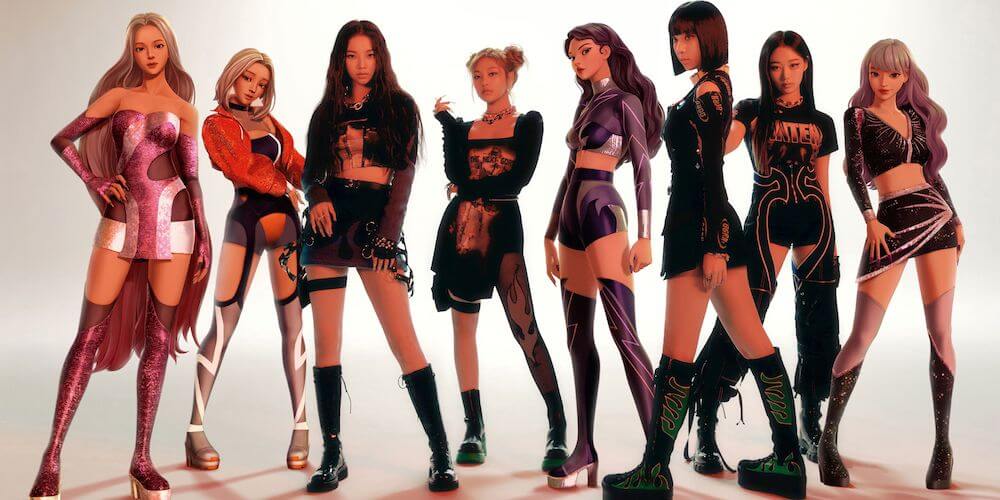The world is becoming Ready Player One (and/or The Matrix, and/or Black Mirror…), and there’s one K-pop girl group leading us towards our digital destiny: aespa. (To be fair, they already warned us they’re on the Next Level.)
While they’re hardly the first (half) virtual act on the music scene, they are perhaps the most ambitious to date.
In just one year since their debut, the half-IRL, half-virtual girl group – made up of NINGNING, WINTER, KARINA and GISELLE and their æ counterparts (their names are always capitalized, as per SM Entertainment’s request) – has already provided enough lore to produce several films worthy of being adopted by Marvel Cinematic Universe.
Except, they’ve already got their own universe: it’s called the SM Entertainment Culture Universe, or SMCU. (More on that in a moment.)
But what about all these words in their lyrics? KWANGYA? KOSMO? “NAVIS, we love you”?
It’s all a lot, depending on how much you wish to engage with the growing mythology, which has been summarized better elsewhere, including a glossary of key aespa universe terminology, should you wish to take a deeper dive.
For what’s it worth, even if you’ve got no ænergy to figure out how to help these ladies defeat the villainous Black Mamba, their songs, performances and music videos objectively slap.
These are forward-thinking, hyper pop-influenced bops, and their Savage mini-album easily stands out as a highlight of 2021.
Half their songs sound like eight different tracks in one, complete with clanging, disjointed, utensils-in-the-sink (SYNK!)-disposal noises and Charli XCX and PC Music-adjacent production, all brought to life through the expert, precise singing and dancing skills we’ve come to expect from graduates of the K-pop training system.
SM’s obviously seen the global success of some of the biggest K-pop acts that have managed to successfully crossover in recent years (like BTS and BLACKPINK, among others) – not that they didn’t help to pave the path with early international efforts, like BoA‘s still-excellent 2009 English album.
But the agency is clearly aiming for even bigger exposure with aespa: the girls made their U.S. television debut on The Kelly Clarkson Show last month (a Kellegendary pick for their premiere, if you ask me), and the girls are now set to become the first K-pop group to perform during the Macy’s Thanksgiving Day Parade in a few days.
But they’re not just going for global domination in the traditional charts-and-sales sense of the music industry: they’re taking over the (digital) universe, too.
Accelerated by the ways we were forced to adapt to working and communicating with each other while social distancing over the past year and a half amid the pandemic, as well as how many people continue to escape the horrors of the real world by entering into digital utopias (see: Animal Crossing), the “metaverse” concept is becoming a mainstream reality.
Last week, SM founder Soo-Man Lee appeared at Solana Foundation’s Breakpoint 2021 conference in Portugal to discuss the company’s moves, describing aespa as the “first girl group with a metaverse worldview, where the members exist together with their self-created avatars that are in a virtual world.”
“Due to the rise in aespa’s popularity, the concept of metaverse is gaining attention in the entertainment industry,” he said, describing the SMCU as “a future entertainment world without a boundary between reality and virtuality that connects the world through culture.”
Of course, other companies like Meta, or The Artist Formerly Known as Facebook, are making headlines by trying to develop metaverses themselves, but the girls have been steadily laying the groundwork for well over a year now.
This isn’t even the first time SM discussed building a metaverse with aespa. In fact, CEO Sung Su Lee was talking about it at 2021 STARTUP:CON over a month ago, before the Facebook announcement even officially happened.
In a speech called SM Content Roadmap – The Future Content Era as seen through SMCU, he spoke about how Soo-Man Lee predicted “the future becoming a world of robots and celebrities, as well as avatars, and since, has been preparing for the future content era for decades,” adding that “with the debut of a ‘Metaverse Girl Group’ aespa with avatars last year, SM presented the reality of a massive virtual world that starts with aespa’s storytelling. This is the metaverse that SM visualizes, and is SM’s culture universe called SMCU.”
He also gave some of the first details about the SMCU experience: “The main keyword of SMCU is ‘KWANGYA’ and holds a symbolic meaning as it encompasses both real and virtual worlds. K-POP fans call our relocated SM Headquarters in Seongsu-Dong and the Seoul Forest area ‘KWANGYA.’ It’s our goal for ‘KWANGYA,’ an infinite virtual universe, to expand as the concept of space that refers to our new location and become the landmark of SMCU.”
“We will reach the next level by creating an expanding universe of metaverse-styled IP content that connects the various and independent IPs of artists, music, music videos, performances, etc. within SMCU to one another,” he added, (unintentionally?) name-dropping one of aespa’s big hits.
It’s a lot of industry and tech jargon, I know, but basically, buckle up: things are about to change even more rapidly in the entertainment industry, going digital in a way like never before.
It’s as exciting as it is sort of frightening and dystopian. Online concerts are already becoming more of a thing in the Pandemic Era, as well as virtual meet-and-greets. Who knows what’s coming next? More advanced VR technology for fan meet-ups? Customizable album experiences via NFT releases? K-pop cryptocurrency? I’d invest in SM Coin this second if I could, honestly.
One thing is absolutely certain: I am ready to pack up and go wherever aespa is heading next. NAVIS, wait for me!
These songs are featured on the MuuTunes Spotify playlist. Subscribe!
You can also subscribe to MuuTunes on Apple Music.
Photo credit: SM Entertainment
